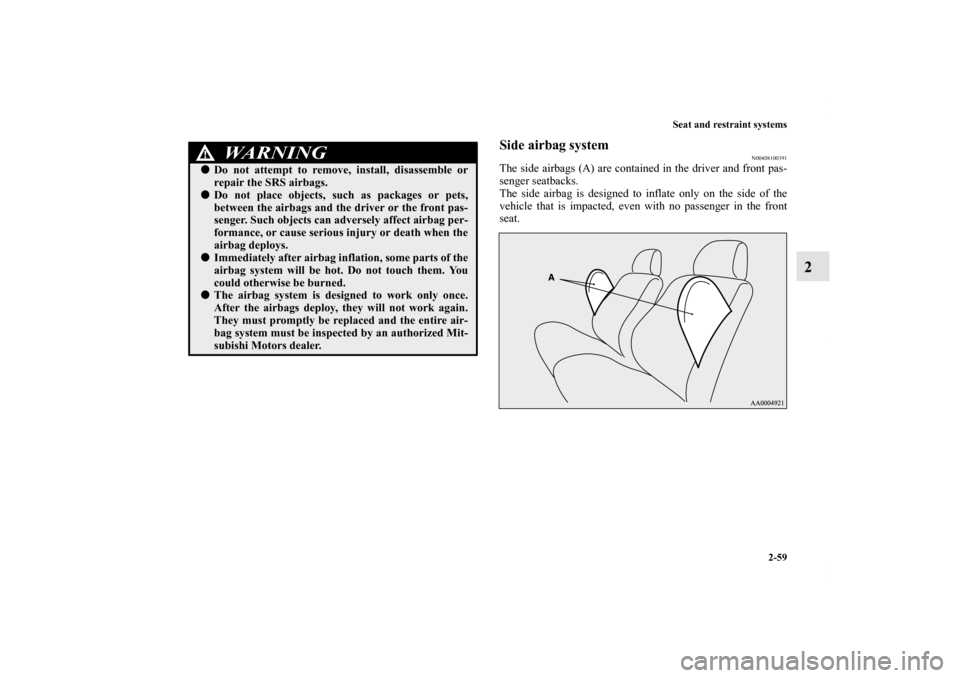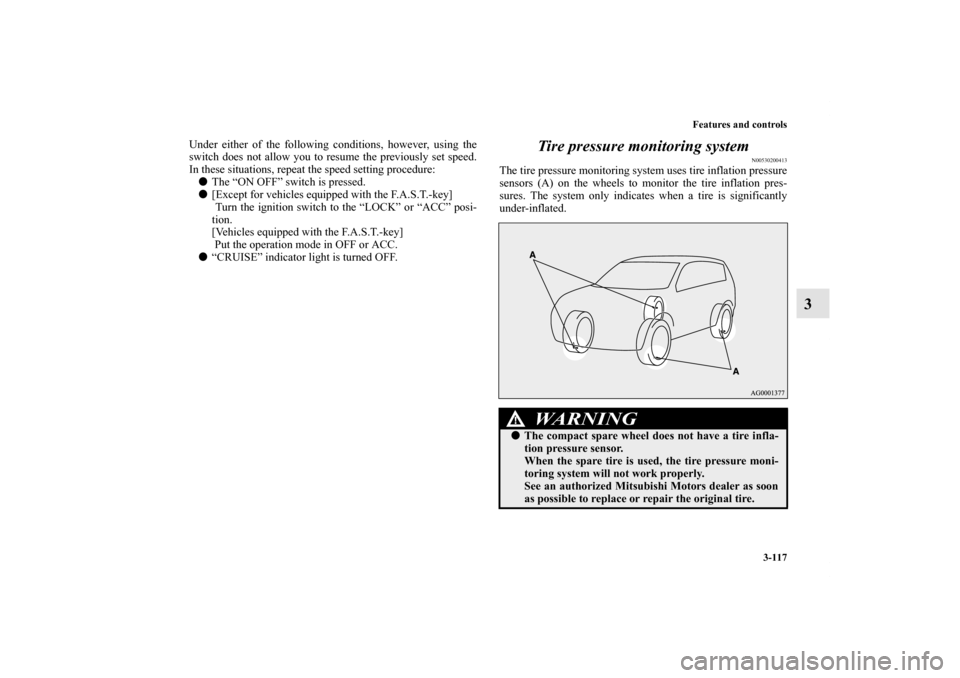Page 9 of 610
Overview
Tire pressure monitoring system
P. 3 - 1 1 7
Changing tires P.6-8
Size of tires and wheels P.7-23
Tire inflation pressure P.7-27
Tire rotation P.7-30
Tire chains P.7-32 License plate light
P.3-188, 7-48, 7-67F.A.S.T.-key (Free-hand Advanced Security
Transmitter) (if so equipped) P.3-14
Keyless entry sysetm (if so equipped) P.3-33
Locking and unlocking P.3-38 High-mounted stop light
P.7-48, 7-69Antenna P.5-102
Rear window wiper
P. 3 - 2 0 6
Back-up light P.7-48, 7-65
Tail and stop light/Rear side-marker lights
P.3-188, 7-48, 7-63Turn signal lights P.3-188, 7-48, 7-63 Rear spoilerLiftgate P.3-44
Rear-view camera
(if so equipped) P.3-123
BK0140300US.book 7 ページ 2011年6月28日 火曜日 午後5時18分
Page 11 of 610

2 Quick indexAnti-lock braking system warning
light�When this light comes on, the anti-lock braking system is not functioning and
only the ordinary braking system is functioning.
�Park your vehicle in a safe place and stop the engine.
Test the system as described on page 3-100.
�If the light does not go out after the test, or if it comes on again, we recom-
mend that you have the system checked at an authorized Mitsubishi Motors
dealer or a repair facility of your choice as soon as possible.P. 3-100
SRS warning light�It is not necessary to stop the vehicle immediately, but we recommend that
you have the airbag and the pre-tensioner seat belt system checked at an
authorized Mitsubishi Motors dealer as soon as possible.P. 2-52
Tire pressure monitoring system
warning light�If the warning light comes on, you should stop and adjust the tires to the
proper inflation pressure as soon as possible.
(See “Tire inflation pressures” on page 7-27.)
Once adjustments have been made, the warning light will go off after a few
minutes of driving.
�If the warning light blinks for approximately 1 minute and then remains con-
tinuously illuminated, the system is not operating properly. If the system
returns to normal, the warning light will go off. If the warning light does not
go off, have the vehicle inspected at an authorized Mitsubishi Motors dealer.P. 3 - 1 1 7
Warning lights
Do this
Ref. Page
BK0140300US.book 2 ページ 2011年6月28日 火曜日 午後5時18分
Page 16 of 610
Quick index
7
Problem
Do this
Ref. Page
The brakes are not functioning
properly after crossing a pud-
dle or stream.Dry out the brakes by driving slowly while lightly pressing the brake pedal.P. 3-92,
P. 4 - 8
The continuously variable
transmission (CVT) makes no
shift change when accelerat-
ing. The initial movement of
the vehicle is slow when the
vehicle starts moving.
(for vehicles with CVT)There may be a problem in the CVT.
If the or warning lights on the multi-information display will not turn off, or if they
come on frequently, please have the vehicle checked at your nearest Mitsubishi Motors
dealer.P. 3-80
A tire is punctured.
1. Park the vehicle in a safe place where the surface is flat and level.
2. Replace the flat tire with the spare tire.P. 6 - 8
BK0140300US.book 7 ページ 2011年6月28日 火曜日 午後5時18分
Page 86 of 610

Seat and restraint systems
2-59
2
Side airbag system
N00408100391
The side airbags (A) are contained in the driver and front pas-
senger seatbacks.
The side airbag is designed to inflate only on the side of the
vehicle that is impacted, even with no passenger in the front
seat.
WA R N I N G
!�Do not attempt to remove, install, disassemble or
repair the SRS airbags.�Do not place objects, such as packages or pets,
between the airbags and the driver or the front pas-
senger. Such objects can adversely affect airbag per-
formance, or cause serious injury or death when the
airbag deploys.�Immediately after airbag inflation, some parts of the
airbag system will be hot. Do not touch them. You
could otherwise be burned.�The airbag system is designed to work only once.
After the airbags deploy, they will not work again.
They must promptly be replaced and the entire air-
bag system must be inspected by an authorized Mit-
subishi Motors dealer.
BK0140300US.book 59 ページ 2011年6月28日 火曜日 午後5時18分
Page 190 of 610

Features and controls
3-93
3 Cautions on the handling of 4-wheel drive
vehicles
N00530800187
Tires and wheelsSince the driving torque can be applied to the four wheels, the
driving performance of the vehicle when operating in 4-wheel
drive is greatly affected by the condition of the tires.
Pay close attention to the tires.
�Install only the specified tires on all wheels. Refer to
“Tires and wheels” on page 9-8.
�Be sure all four tires and wheels are the same size and
type.
When it is necessary to replace any of the tires or wheels,
replace all four.
�All tires should be rotated before the wear difference
between the front and rear tires is recognizable.
Good vehicle performance cannot be expected if there is a dif-
ference in wear between tires. Refer to “Tire rotation” on page
7-30.
�Check the tire inflation pressure regularly.
CAUTION
!�Always use tires of the same size, type, and brand
that have no wear differences. Using tires of differ-
ent size, type, brands or degree of wear, will increase
the differential oil temperature and result in possi-
ble damage to the driving system. Further, the drive
train will be subject to excessive loading, possibly
leading to oil leakage, component seizure, or other
serious failures.
BK0140300US.book 93 ページ 2011年6月28日 火曜日 午後5時18分
Page 214 of 610

Features and controls
3-117
3
Under either of the following conditions, however, using the
switch does not allow you to resume the previously set speed.
In these situations, repeat the speed setting procedure:
�The “ON OFF” switch is pressed.
�[Except for vehicles equipped with the F.A.S.T.-key]
Turn the ignition switch to the “LOCK” or “ACC” posi-
tion.
[Vehicles equipped with the F.A.S.T.-key]
Put the operation mode in OFF or ACC.
�“CRUISE” indicator light is turned OFF.
Tire pressure monitoring system
N00530200413
The tire pressure monitoring system uses tire inflation pressure
sensors (A) on the wheels to monitor the tire inflation pres-
sures. The system only indicates when a tire is significantly
under-inflated.
WA R N I N G
!�The compact spare wheel does not have a tire infla-
tion pressure sensor.
When the spare tire is used, the tire pressure moni-
toring system will not work properly.
See an authorized Mitsubishi Motors dealer as soon
as possible to replace or repair the original tire.
BK0140300US.book 117 ページ 2011年6月28日 火曜日 午後5時18分
Page 215 of 610

3-118 Features and controls
3
NOTE�The tire pressure monitoring system is not a substitute for
regularly checking tire inflation pressures.
Be sure to check the tire inflation pressures as described in
“Tires” on page 7-23.
�Each of the grommets and washers where the tire inflation
pressure sensors are mounted should be replaced with new
ones when the tire is replaced.
For details, contact your authorized Mitsubishi Motors
dealer.
The tire pressure monitoring system warning
light / display
N00532700281
When the ignition switch is turned to the “ON” position or the
operation mode is put in ON, the tire pressure monitoring sys-
tem warning light normally illuminates and goes off a few sec-
onds later.
If one or more of the vehicle tires (except for the spare tire) is
significantly under-inflated, the warning light will remain illu-
minated while the ignition switch or the operation mode is in
ON.
Refer to “If the warning light / display illuminates while driv-
ing” on page 3-121 and take the necessary measures.NOTE�In addition, the warning display is displayed on the infor-
mation screen in the multi-information display.
Grommet
Tire inflation
pressure sensorWa s h e r
BK0140300US.book 118 ページ 2011年6月28日 火曜日 午後5時18分
Page 217 of 610

3-120 Features and controls
3
Ty p e 1
Ty p e 2
Each tire, including the spare (if provided), should be checked
monthly when cold and inflated to the inflation pressure rec-
ommended by the vehicle manufacturer on the vehicle placard
or tire inflation pressure label. (If your vehicle has tires of a
different size than the size indicated on the vehicle placard or
tire inflation pressure label, you should determine the proper
tire inflation pressure for those tires.)
As an added safety feature, your vehicle has been equipped
with a tire pressure monitoring system (TPMS) that illuminates
a low tire pressure telltale when one or more of your tires is
significantly under-inflated.
Accordingly, when the low tire pressure telltale illuminates,
you should stop and check your tires as soon as possible, and
inflate them to the proper pressure. Driving on a significantly
under-inflated tire causes the tire to overheat and can lead to
tire failure.
Under-inflation also reduces fuel efficiency and tire tread life,
and may affect the vehicle’s handling and stopping ability.
Please note that the TPMS is not a substitute for proper tire
maintenance, and it is the driver’s responsibility to maintaincorrect tire pressure, even if under-inflation has not reached the
level to trigger illumination of the TPMS low tire pressure tell-
tale.
Your vehicle has also been equipped with a TPMS malfunction
indicator to indicate when the system is not operating properly.
The TPMS malfunction indicator is combined with the low tire
pressure telltale.
When the system detects a malfunction, the telltale will flash
for approximately one minute and then remain continuously
illuminated. This sequence will continue upon subsequent
vehicle start-ups as long as the malfunction exists.
When the malfunction indicator is illuminated, the system may
not be able to detect or signal low tire pressure as intended.
TPMS malfunctions may occur for a variety of reasons, includ-
ing the installation of replacement or alternate tires or wheels
on the vehicle that prevent the TPMS from functioning prop-
erly. Always check the TPMS malfunction telltale after replac-
ing one or more tires or wheels on your vehicle to ensure that
the replacement or alternate tires and wheels allow the TPMS
to continue to function properly.BK0140300US.book 120 ページ 2011年6月28日 火曜日 午後5時18分